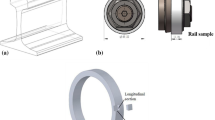Abstract
Laser cladding has been applied to reduce the wear on rails in a curved track. It is important to evaluate the wear and rolling contact fatigue (RCF) characteristics of laser cladding rails. This paper evaluated the wear characteristics of three types of laser cladding, i.e., Stellite 21, Inconel 625, and Hastelloy-C. The wear of Stellite 21 was reduced by 83% as compared to the untreated rail specimen, while those of Inconel 625 and Hastelloy C were decreased by 42% and 29%, respectively. Meanwhile, when laser cladding is applied, a cladding boundary between the rail and the laser cladding is created. The cladding boundary consists of the rail base material, the heat-affected zone, and laser cladding. At the cladding boundary, various types of microstructures are distributed, and as a result the hardness changes. The wear and RCF characteristics of the cladding boundary caused by rolling contact loads have been evaluated through twin-disc tests. Since Stellite 21 has low hardness at the cladding boundary, it suffered the most severe wear and damages in three types of laser cladding. If laser cladding is applied to reduce the wear of the curved track, the damage of the boundary, as opposed to the wear characteristics, should be taken into consideration. In this paper, Stellite 21 exhibits the best wear characteristics, but Hastelloy C is found to be the most appropriate when simultaneously considering both the wear and RCF of the cladding boundary.


















Similar content being viewed by others
Abbreviations
- E:
-
Young’s modulus
- L:
-
Specimen width
- Nr :
-
Numbers of rotation for rail specimen
- Nw :
-
Numbers of rotation for wheel specimen
- P:
-
Applied load
- Rr :
-
Radius of rail specimen
- Rw :
-
Radius of wheel specimen
References
Tyfour, W. R., Beynon, J. H., & Kapoor, A. (1995). The steady state wear behavior of pearlitic rail steel under dry rolling-sliding contact condition. Wear, 180, 79–89.
Lewis, R., & Olofsson, U. (2004). Mapping rail wear regimes and transitions. Wear, 257, 721–729.
Cuervo, P. A., Santa, J. F., & Toro, A. (2015). Correlations between wear mechanisms and rail grinding operations in a commercial railroad. Tribology International, 82, 265–273.
European Standard (2011). Railway applications – track –Rail. In EN 13674.
Korean Standard (2012) Head Hardened Rails. In KS R 9110.
Grassie, S. L. (2009). Rail corrugation: characteristics, causes and treatments. IMehcE Part F, 223, 1–18.
Saulot, A., Descartes, S., Desmyter, D., Levy, D., & Berthier, Y. (2006). A tribological characterization of the damage mechanism of low rail corrugation on sharp curved track. Wear, 260, 984–995.
Workman, D., Kral, R. (2011) Flash butt wedge repair of weld head defects. In Proceedings of the ASME/ASCE/IEEE 2011 joint rail conference (pp. 1–7).
Jun, H.-K., Seo, J.-W., Jeon, I.-S., Lee, S.-H., & Chang, Y.-S. (2016). Fracture and fatigue crack growth analyses on a weld-repaired railway rail. Engineering Failure Analysis, 59, 478–492.
Wang, W. J., Hu, J., Guo, J., Liu, Q. Y., & Zhu, M. H. (2014). Effect of laser cladding on wear and damage behaviors of heavy-haul wheel/rail materials. Wear, 311, 130–136.
Lewis, S. R., Fretwell-Smith, S., Goodwin, P. S., Smith, L., Lewis, R., Aslam, M., et al. (2016). Improving rail wear and RCF performance using laser cladding. Wear, 366-367, 268–278.
Lewis, S. R., Lewis, R., & Fletcher, D. I. (2015). Assessment of laser cladding as an option for repairing/enhancing rails. Wear, 330–331, 581–591.
Guo, Huo-ming, Wang, Qian, Wang, Wen-jian, Guo, Jun, Liu, Qi-yue, & Zhu, Min-hao. (2015). Investigation on wear and damage performance of laser cladding Co-based alloy on single wheel or rail material. Wear, 328–329, 329–337.
Quan, L., Ralph, A., Wenyi, Y., Cong, Q., Peter, M., Anna, P., et al. (2017). Investigation of a novel functionally graded material for the repair of premium hypereutectoid rails using laser cladding technology. Composites: Part B, 130, 174–191.
Seo, J. W., Jun, H. K., Kwon, S. J., & Lee, D. H. (2018). Effect of friction modifier on rolling contact fatigue and wear of wheel and rail materials. Tribology Transactions, 61(1), 19–30.
Simone Z. (2015) Laser cladding with metallic powder. Ph.D. thesis, University of Trento, Deptartment of Material Science and Engineering, Italy.
Beynon, J. H., Garnham, J. E., & Sawley, K. J. (1995). Rolling contact fatigue of three pearlitic rail steels. Wear, 192, 91–111.
Seo, J. W., Kwon, S. J., Lee, D. H., & Choi, H. Y. (2013). Analysis of contact fatigue crack growth using twin-disc tests and numerical evaluations. International Journal of Fatigue, 55, 55–63.
Acknowledgements
This research was supported by a grant from the R&D Program of the Korea Railroad Research Institute, Republic of Korea.
Author information
Authors and Affiliations
Corresponding authors
Additional information
Publisher's Note
Springer Nature remains neutral with regard to jurisdictional claims in published maps and institutional affiliations.
Rights and permissions
About this article
Cite this article
Seo, JW., Kim, J., Kwon, SJ. et al. Effects of Laser Cladding for Repairing and Improving Wear of Rails. Int. J. Precis. Eng. Manuf. 20, 1207–1217 (2019). https://doi.org/10.1007/s12541-019-00115-y
Received:
Revised:
Accepted:
Published:
Issue Date:
DOI: https://doi.org/10.1007/s12541-019-00115-y



